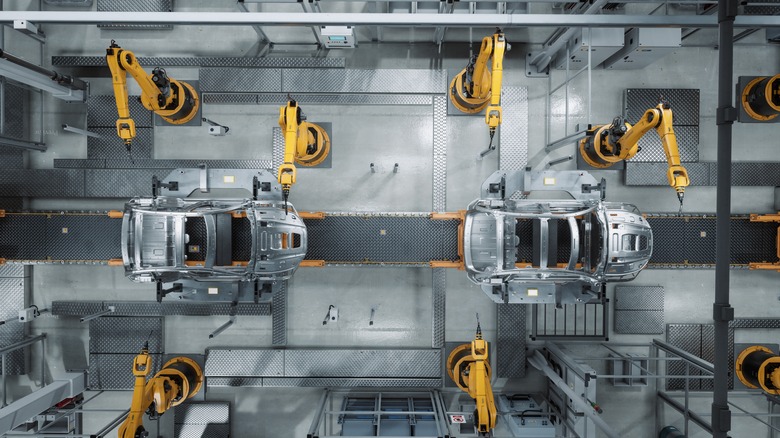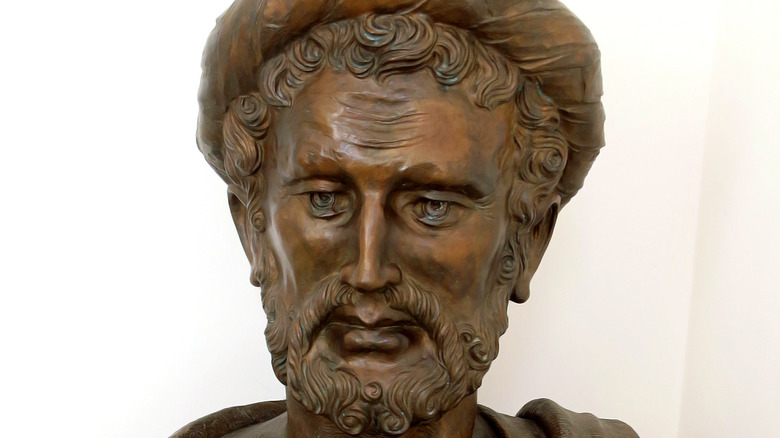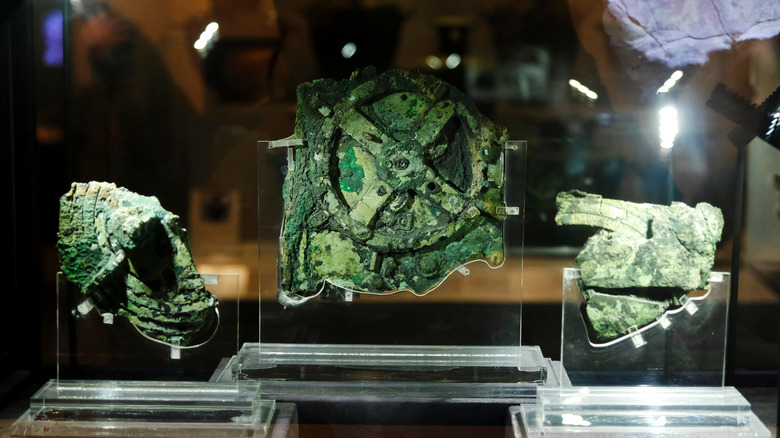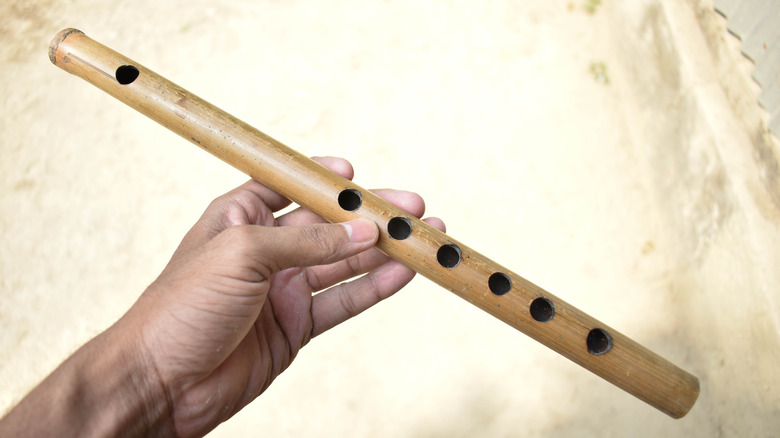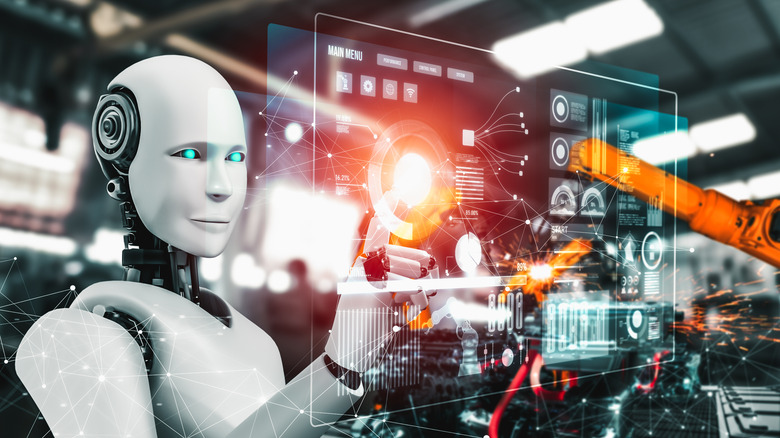Robots Have Been Used For Longer Than You Might Think
In the 21st century world, robots are a part of everyday life. At factories, robots have increasingly taken over jobs on the assembly line that once belonged to humans, and some of these facilities have become completely robo-run (via CNBC). Meanwhile, everyday people in the developed world use artificially intelligent technologies like Siri, Alexa, or Google to be digital assistants that help perform small tasks throughout their days. Some people have robot vacuum cleaners that sweep the house completely autonomously. But that begs the question: What exactly is a robot?
A robot can be a whole variety of different things. In science fiction, robots are often depicted as human-like androids, who almost always end up overthrowing the entire human species. But they don't have to be human-like, animal-like, or anything that resembles a living creature on Earth. According to Britannica, "[A robot is] any automatically operated machine that replaces human effort, though it may not resemble human beings in appearance or perform functions in a humanlike manner." Using this definition, there have been many attempts at creating robots throughout human history, and some that helped create the groundwork for our mechanical friends today.
Contraptions of the Ancient Greeks
One of the earliest examples of a robot being created was Archytas' Pigeon, according to Interesting Engineering. The pigeon-like machine was made out of wood, and inside there was a boiler that produced enough steam to make the device go airborne, all by itself.
The brilliance of the Greeks doesn't stop with robot pigeons, however; they created robot bartenders as well. Known as the automatic servant of Philon, this contraption was a human-like statue that was dressed like a maid, holding a jug filled with wine in its left hand, and holding out its right hand for someone to come along and place the cup. When you placed the cup on its right hand, it would pour out wine. Inside the mechanism, there were two separate containers of wine and water, which were connected to the jug through two separate tubes. When the person placed their cup on the right hand, the cup would fill up with wine, until the weight of the cup pushed the right hand down far enough that the wine tube would no longer pour through the jug, and the rest of the cup would be filled with water, according to the Kotsanas Museum.
Ancient computers and automatic doors
In all seriousness, the Greeks didn't just use their genius for creating entertainment. Other useful and astounding mechanisms were created by inventors of the ancient past. One of these creations was the Antikythera mechanism, which is considered to be the world's first computer, according to Smithsonian. The device worked by compiling different, interlocking gears together, and when a knob was turned, seven hands would move at different speeds that told the rotations of celestial objects, such as the sun or moon. By "programming" this computer, the mechanism would be able to act as a calendar and also predict when solar and lunar eclipses would occur (via Smithsonian).
One ancient Greek inventor, Heron of Alexandria, invented automatic doors using fire within temple altars. His contraption worked by using fire burning within an altar, which was connected to a vessel directly underneath it. Inside the vessel there was water, and when the heat from the altar would be pushed downwards, the water inside the first vessel would be forced up a tube that was connected to a second vessel. This vessel, which was hanging from a ceiling and connected to the doorposts, would then fill up with water, and as the vessel got heavier, it would pull down the ropes it was connected to and open the doors to the temple, according to Artefacts. After the fire was extinguished, the heat would dissipate and the doors would close.
Musical robots
Flash forward to the 18th century, and mathematicians began constructing robots that could perform musical tasks. One robot, called The Flute Player, was invented by Jacques de Vaucanson in 1737 (via Interesting Engineering). The device worked by having nine separate bellows divided up into three different groups that were all connected to the chest of the robot. Each group of bellows was weighted differently so they would produce different air frequencies, and the robot would then "breathe air" into the flute it was holding, according to The Guardian. The robot also had a metal tongue which was used to regulate airflow and create different notes as it fingered the flute with its hands.
Another astounding musical creation was the Euphonia, invented in 1846 by Joseph Faber, according to Atlas Obscura. This robot had the appearance of a female human head, and behind the head, there was a piano keyboard. Fourteen separate piano keys controlled the mouth movements of the robot, and when you played the keys, the machine would talk. This was seen as not only the first robot that could sing, but the first text-to-speech device ever created, according to Interesting Engineering.
The future of robotics
Today robots are only becoming an increasingly integral part of how our world functions, a trend that isn't stopping any time soon. Robots today are used for scientific purposes, such as the Mars rovers, which have the capabilities to not only land on a different celestial object other than our home planet, but to take pictures and collect samples for scientists to study back on Earth. Robots are used for entertainment purposes, with many households in the developed world having robot dogs that play and interact with people. One robot in particular, Sophia, which was developed to look like a person and mimic human behavior, was even granted citizenship in Saudi Arabia in 2017, according to Interesting Engineering.
As humanity progresses into the future, advancements in robotics and technology will only continue to change people's lives. The Massachusetts Institute of Technology announced in April 2022 that they invented a device that could allow a surgeon to operate on a patient remotely with a joystick. The machine is used to treat strokes that are caused by blood clots, according to MIT. Other technologies, like self-driving cars and 3D printing, are only becoming more popular, according to Revolutionized. If there's anything for certain, it's that robotics isn't at its peak, but rather is merely beginning.
